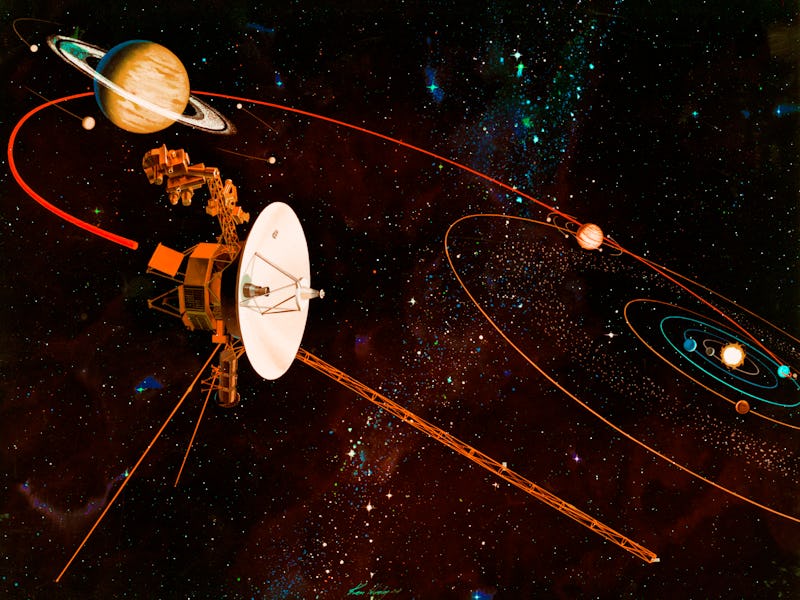14.6 billion miles away, NASA gets Voyager 1 talking again — and discovers a new mystery
That’s some repair job.

NASA’s Voyager 1 is on a fraught and unknowable journey into deep space. Some 14.6 billion miles from Earth, it and its sister craft, Voyager 2, are the furthest human-made objects from our planet, having made it beyond the edges of the Solar System and out into the interstellar medium. At such distances, anything can go wrong. Add to that the fact that these are old craft: The Voyagers launched in the 1970s. So when Voyager 1 started to send home weird, garbled nonsense instead of telemetry data in May of this year, NASA engineers might have been forgiven for calling it a day and pouring one out for perhaps the most successful space mission of all time.
But that’s not how NASA works. Instead, they started working on a remote diagnosis and fix for the record-breaking spacecraft. Now, some four months later, they are triumphant. Voyager 1 is back online and communicating perfectly with ground control as if it never happened. In fact, the fix turned out to be relatively simple — or as simple as anything can be with a 22-hour communications lag in each direction and billions of miles of space in between.
What happened to Voyager 1?
The high-gain antenna, shown on the left in this illustration, is how Voyager 1 sends and receives radio communications with NASA engineers here on Earth.
Cruising in interstellar space, the 45-year-old spacecraft appeared to be operating shockingly well and was transmitting reams of data back to Earth. But in mid-May, Voyager 1’s onboard system responsible for keeping its high-gain antenna pointed at Earth, known as the attitude articulation and control system, or AACS, started beaming home confusing jumbles of data instead of the usual reports about the spacecraft’s health and status. From our viewpoint, it appeared as if the spacecraft had developed something like an electronic version of aphasia — a condition that causes the loss of fluent speech.
“The data may appear to be randomly generated, or does not reflect any possible state the AACS could be in,” explained NASA in a statement from the time.
Even more bafflingly for engineers, Voyager 1 appeared to be in perfect condition despite the spacecraft’s bizarre status reports. The radio signal from the ship remained strong and steady, which meant the antenna was still pointed at Earth — and not in whatever configuration the AACS was claiming it was in to NASA in the reports. Similarly, Voyager 1’s science systems kept gathering and transmitting data as usual, without any of the same strangeness affecting the AACS. And, whatever was wrong with the AACS didn’t trip a fault protection system designed to put the spacecraft in safe mode when there’s a glitch.
Thankfully, NASA engineers diagnosed the problem. And with the diagnosis, they could employ a cure.
The fix — It turned out that the AACS had started sending its telemetry data via an onboard computer that had stopped working years ago. The dead computer corrupted all the outgoing data. All NASA engineers had to do was send the command to the AACS to use the correct computer to send its data home.
But there’s still a problem — The next challenge will be to figure out exactly what caused the AACS to switch computers in the first place. NASA says the system probably received a faulty command from another onboard computer. While they say it is not a major concern for Voyager 1’s well-being right now, the true culprit will need to be found and fixed to prevent future weirdness.
Voyager 1 lives on
Voyager 1 has yielded revelations about our Solar System no one could have predicted.
Currently, Voyager 1 is more than 23.4 billion kilometers or 14.6 billion miles (and gaining, most of the time) from Earth. You can watch the distance grow and see both Voyager spacecraft’s current positions in space on NASA’s website.
For the last decade, Voyager 1 has been cruising in interstellar space, beyond the reach of our Sun’s magnetic field. The field had offered the craft a little protection from cosmic rays and other interstellar radiation, much as Earth’s magnetic field offers some protection from high-energy particles and radiation from the Sun. Cosmic rays are known to interfere with electronics here on Earth — when one of those high-speed energetic particles strikes a computer chip, it can cause small memory errors, which add up over time — and it’s reasonable to expect that to be an issue for Voyager 1’s onboard computers, too.
“A mystery like this is sort of par for the course at this stage of the Voyager mission,” said Voyager 1 and 2 project manager Suzanne Dodd in a statement dated to May.
“The spacecraft are both almost 45 years old, which is far beyond what the mission planners anticipated. We’re also in interstellar space — a high-radiation environment that no spacecraft have flown in before.”
We’ll need to wait and see what new perils encounter Voyager next on its travels — and what new discoveries await.
Subscribe for free to Inverse’s award-winning daily newsletter.
This article was originally published on